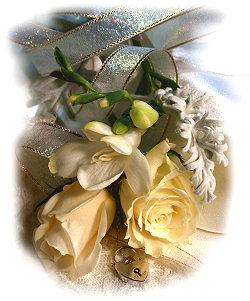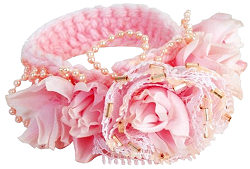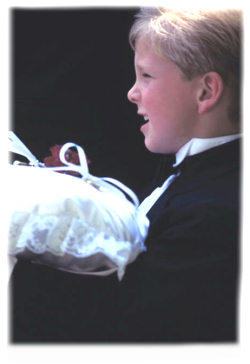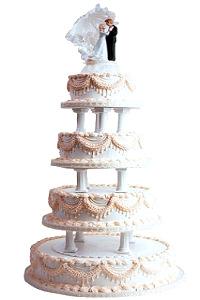|
 Your wedding is one of the most important events in your life and the ceremony and tradition involved are an integral part of the day. Wedding ceremonies and customs vary greatly based on your religion or the country you're in. Some countries, cultures and religions recognize the marriage as soon as the wedding ceremony begins, others not until a marriage license is signed and then a ceremony is held to celebrate the marriage with friends and family. Some customs are considered traditional by some but are offensive to others.
Your wedding is one of the most important events in your life and the ceremony and tradition involved are an integral part of the day. Wedding ceremonies and customs vary greatly based on your religion or the country you're in. Some countries, cultures and religions recognize the marriage as soon as the wedding ceremony begins, others not until a marriage license is signed and then a ceremony is held to celebrate the marriage with friends and family. Some customs are considered traditional by some but are offensive to others.
We are here to help by going over some of the most common wedding ceremonies and customs and how they can vary based on country or religion. We'll start by going over the most common types of U.S. weddings, then the traditional “White Wedding” and then we’ll look at some other weddings and customs and how they vary by country and religion.
Different Types Of U.S. Weddings
In a white wedding, formal or semi-formal traditions are followed. White weddings are the most popular and most typical type of wedding ceremony. In white weddings British, Irish, American and Commonwealth traditions are usually closely followed.
In a destination wedding the ceremony is usually held in a location that the couple and attendees have to travel to get to, thus the name. Destination weddings usually have a theme of some kind that is related to the destination. You could have a flashy Las Vegas wedding, a tropical beach ceremony in the Caribbean, a simple backyard ceremony somewhere special or something extreme like an underwater wedding.
In a double wedding, two couples marry at the same time in a single wedding ceremony. Often when two siblings are going to marry they will plan a double wedding.
In a military wedding the wedding ceremony is held in a military chapel.
In an online wedding the wedding ceremony is conducted over the Internet, or it can be a cyber-event that takes the place of a real face to face wedding where the couple will use avatars of some kind as stand-ins to be married.
In a same-sex wedding, two people of the same gender are married. Same-sex weddings are not recognized legally everywhere and in places that do not recognize same-sex weddings the event can be an opportunity for the couple to exchange pledges and celebrate the ceremony the same as they would a traditional wedding.
U.S. Weddings
In the United States the traditional western wedding custom of the bride wearing a white dress was, during the Victorian era, intended to symbolize purity, although despite popular misconception not necessarily to indicate virginity. A white face veil is worn with the dress to symbolize virginity. Following strict “White Wedding” tradition, a white dress and veil are not worn for the second or third wedding after becoming a widow or a divorcee.
Another popular custom during a traditional ceremony is “Something old, something new, something borrowed, something blue”. According to this long-standing custom, it is considered good luck for the bride to carry something of each category during the ceremony. Often a bride will try to carry one item that meets all these definitions if possible.
The wedding ceremony is usually followed by a wedding reception where a meal and wedding cake are served. At the reception the guests will toast the newlyweds before the meal and after the meal the bride and groom will cut the wedding cake and serve it to the guests. Another enjoyable tradition during the reception is for guests to randomly clink their silverware on their glass which obliges the newlyweds each time to kiss. After the meal and cake there is dancing, with the newlyweds usually having the first dance.

At some point during the reception gifts and cards are given to the newlyweds. A favorite custom during the reception is for the bride to turn her back and throw her bouquet backwards to a group of all the unmarried women at the wedding, the woman who catches it will be supposedly be the next one to marry! A modern twist has the groom throwing the bride’s garter to a group of the unmarried men with the man catching it being the next male to marry.
Music is an important part of the wedding ceremony and the reception. The most common song used during the wedding processional is the “Bridal Chorus”, also known as “Here Comes the Bride” by Richard Wagner. The “Wedding March” by Felix Mendelssohn and Johann Pachelbel’s “Canon in D” are also often used as a processional march. At the reception a variety of music will be played, usually by a live band. The 1950's Swiss Oom-pah song “Der Ententanz”, commonly known in America as “The Chicken Dance”, has become a popular song to be played at some point during the reception.
White Weddings
The custom of wearing the color white as a wedding dress actually began when Queen Victoria broke convention and wore a white wedding dress for her royal wedding. Prior to that, white was not considered appropriate for a royal wedding but Victoria’s dress popularized white wedding gowns almost immediately and the tradition caught on. At the time new brides would just wear the best clothes they had or would buy the most expensive new clothes they could afford. After Victoria’s wedding, gold dresses or gold threaded dresses became popular with the royals while other brides would wear white or also pastel dresses that usually reflected their social status.
Up to the mid-twentieth century many brides in the United Kingdom didn’t wear a traditional or gown-type wedding dress, they would simply wear a special dress that could be worn again as an evening dress. In America, the same held true for working and pioneer brides that were practical and would go for a formal dress that could be used again on special occasions.
A white wedding will typically take place in a church, and the couple will want to get married in the most beautiful church they can find. This sometimes means that prior to the wedding, the couple will begin to attend the church unexpectedly, even though they would not otherwise go to church, much to the chagrin of the parish. As a result, some churches now require that in order to use the church for their wedding, couples join the parish or pledge to do so in the future. White weddings in the United States can also be held at the family’s home, a private club or somewhere special like a botanical garden, etc.
A full white wedding ceremony includes an organist and maybe a choir for the wedding music. Flower arrangements for the church and lapel flowers as well as keepsake wedding leaflets with the Order of Service need to be purchased to be given out by the ushers at seating.
Wedding Attendees
 The wedding party in a traditional wedding, aside from the bride and groom, include:
The wedding party in a traditional wedding, aside from the bride and groom, include:
- The Best Man - usually the best or closest male friend or a relative of the groom is given this place of honor.
- Maid of honor - usually the best or closest female friend of the bride is given this place of honor. If married, she is called a “matron of honor”.
- Groomsmen - one or more males that support the groom.
- Bridesmaids - one or more females that support the bride.
- Flower girl - a young girl who will scatter flowers in front of the bridal party.
- Ringbearer - usually a young boy, who carries the wedding rings.
- Ushers - usually males, who help with the seating and organization.
- Junior Bridesmaids - a young girl (usually between 8 and 18 years old) who the bride wants to be in the ceremony, but is too old to be a flower girl.
The Wedding Ceremony
When guests arrive at the church they are greeted by the ushers who will give them whatever books, flowers or leaflets are needed for the ceremony and then seat them correctly. Usually the family and friends of the bride will sit on one side of the church and the family and friends of the groom on the other. The front rows are usually reserved for family and close friends. In many ceremonies the bridal party will stand at the alter, but if not they will be seated in the very front rows.
The bride and her entourage will arrive at the church in elegant cars, limos, or even sometimes horse-drawn carriages hired for the ceremony. The bridal entourage typically consists of the bride and her father, all the various bridesmaids, the maids of honor and the flower girls and page boys that are to attend her.
The typical processional order goes like this:
- The ushers and/or groomsmen first escort the grandparents of the bride and groom and seat them.
- The ushers and/or groomsmen then escort the mother of groom and the mother of the bride and seat them.
- Next, the bridesmaids will enter, being escorted by the groomsmen.
- The maid or matron of honor will then enter, either by herself or she will be escorted by the best man.
- The ringbearer will enter next.
- The flower girl then enters. (Sometimes the ringbearer and flower girl will enter together.)
- Finally the bride will enter and take her walk down the aisle, escorted by her father, to the accompaniment of music, typically Wagner’s “The Bridal Chorus”, commonly known as “Here Comes the Bride” and the ceremony will begin.
After the ceremony ends, the bride and groom will go to a side room with the officiate and two witnesses and sign the state-issued marriage license in the United States or in the United Kingdom they sign the wedding register.
The guests will then throw flower petals, rice, birdseed or confetti over the newlyweds as they leave the church and a photographic session is held as they are leaving the church or getting into the cars to go to the reception.
The Wedding Reception
 After the wedding things move to the reception where the newlyweds, their parents, the best man and the wedding entourage greet the guests. The reception usually consists of a catered three course meal, drinks, numerous toasts and speeches and the cutting of the wedding cake by the bride and groom, all accompanied by music.
After the wedding things move to the reception where the newlyweds, their parents, the best man and the wedding entourage greet the guests. The reception usually consists of a catered three course meal, drinks, numerous toasts and speeches and the cutting of the wedding cake by the bride and groom, all accompanied by music.
The dancing is usually started by the bride and groom who commonly get the first dance called the “Bridal Waltz”. Dancing a waltz is actually rare, couples usually choose their favorite love song for their first dance.
After the first dance, a dance between the bride and her father is traditional. Often the groom will cut in halfway through, to symbolize the bride leaving her father and joining her husband. In America, dances between the groom and his mother are also becoming popular.
Usually the newlyweds will be the victim of some sort of good-natured hazing or “shivaree”. This is the typical custom of tying tin cans to the car bumper or putting shaving cream on the car windows.
Finally the newlyweds are ready to set out on their honeymoon. Newlyweds try to celebrate honeymoons in places that are in some way special and romantic to them. Sometimes they will be secluded, sometimes exotic or warm or somehow special to the couple. Recently couples will combine the wedding and honeymoon into one location or substitute one for the other.
Italian Weddings
In an Italian wedding the reception will begin with a cocktail hour where the bridal party and the guests separate for an hour and are served cocktails. During the cocktail hour food is served buffet style and the bride and groom will usually take this time to have photographs taken.
After cocktail hour the guests gather in the main dining room. The bride and groom enter and are formally introduced as husband and wife for the first time. The newlyweds then take the first dance with the wedding party soon joining in and then the rest of the guests. After some dancing, everyone is seated and speeches are given by family and friends and everyone joins in a champagne toast to the bride and groom.
Food is served throughout the reception, usually a three course meal with plenty of dancing in between and then it is time for the bride and groom to cut the wedding cake just before the dessert course begins. Sicilian custom includes what is called “Venetian Hour” where a huge selection of pastries, fruit, cakes and coffees are served on what is called a “Venetian Table” amidst much celebration.
After dessert is served there is more dancing and then gifts are given to the bride and groom. A tradition in Southern Italy is for the guests to give envelopes of money to the newlyweds who give a small token of appreciation called a wedding favor. In Northern Italy there is no tradition of envelopes with money, but the wedding favor is still given.
Christian Weddings
Christian weddings and receptions are very similar to the traditional Italian wedding. The specific customs and traditions can vary based on the ethnic group, social group or what part of the country the wedding is in.
First, engraved invitations are sent out to the wedding guests and hand addressed for a personal touch. The guests then send or deliver wedding gifts to the bride’s home before the wedding day. The wedding ceremony takes place at a church or other special location of choice such as a botanical garden or a back yard. The wedding reception will follow either at the same place or somewhere else.
At the reception the bridal party lines up in a receiving line and the wedding guests file past and introduce themselves. Snacks and a meal are usually served while the guests and newlyweds spend time together. Usually the best man and maid of honor will then toast the bride and groom with best wishes, stories and personal thoughts and some of the other guests will follow with their own toasts. Champagne, or some kind of nonalcoholic option are used for the toast.
The bride and groom will then take the first dance together. Often the bride and groom will exchange dances with their respective parents, then sometimes dance with the wedding party then the bride and groom will dance together again while the wedding party joins in and then the rest of the guests will follow. Some cultures will have a money dance where guests will actually pin money on the bride and groom to help them get started with their new life and home. Some other cultures would considered this to be vulgar. Music is usually provided by a live band but sometimes a disc jockey or stereo are used.
After the meal is served and the toasting done the cake-cutting ceremony takes place. The bride and groom both hold a cake cutter, usually a gift given as a keepsake, and cut the first slices of cake. An enjoyable highlight of the cake cutting ceremony in Christian weddings is after cutting the first slice, the bride and groom will feed each other cake and often this will lead to smearing cake on each other’s faces. In some groups this would be considered vulgar.
After the cake-cutting the bride at some point will toss the bouquet. She will turn her back toward a group of all the unmarried women at the wedding and toss the bouquet backwards over her shoulder. Superstition says that the lucky woman who catches it will be the next to marry. In some groups the groom will do the same with the brides garter, throwing it to a group of all the unmarried men with the same intent.
Gifts are usually opened ahead of time and sometimes displayed at the reception and guests that bring gifts will place them on a gift table for the bride and groom to take home and open later.
Jewish Weddings
In a Jewish wedding the bride and groom will sign a marriage contract called a Ketubah. The Ketubah originally documented the bride’s legal status as wife, but now also sets out expectations for the marriage and is kept as a keepsake and is framed and hung in the couple’s home.
The Jewish wedding ceremony will begin with the couple being escorted by their parents into a wedding canopy called a Huppah. The ceremony is conducted by a Rabbi and takes place under the Huppah. The couple exchanges vows, seven marriage blessings are read and then the groom will smashes a wine glass under his foot.
The couple will usually spend some time alone together before joining the reception, which is similar to other wedding receptions with food, music and dancing. Jewish wedding receptions will have a wedding breakfast and traditional dances include the Hora, the Krenzl and the Mizinke. During the reception the guest’s will participate in the “Gladdening of the Bride” when they circle the bride and sing praise to her.
One important change has been with the wedding place cards for the table seating, which now list the husband and wife’s first names. To list only the husband’s name (e.g., Mr. and Mrs. Bernard Schwartz) is actually considered a slight toward women in general and the specific couple.
Wedding Gifts
 The original purpose of inviting guests to a wedding was to have them there as witnesses to the ceremony and have them share in the celebration. Giving wedding gifts has always been optional, but since the beginning, most guests have given at least some small gift as a gesture of appreciation for being invited and good wishes for the newlyweds. Some couples and their families feel a gift is expected because of the effort and expense they put into the wedding and giving the guests a great time. There is no formal etiquette on this point.
The original purpose of inviting guests to a wedding was to have them there as witnesses to the ceremony and have them share in the celebration. Giving wedding gifts has always been optional, but since the beginning, most guests have given at least some small gift as a gesture of appreciation for being invited and good wishes for the newlyweds. Some couples and their families feel a gift is expected because of the effort and expense they put into the wedding and giving the guests a great time. There is no formal etiquette on this point.
Modern day gift giving often has the couple registering for gifts at a favorite store in advance of the wedding. This enables them to obtain household items such as cookware, linens, china, silverware, small appliances and other similar gifts. Older brides and grooms that already have a lot of these items sometimes register at home improvement or hardware stores. Gift registries are designed to make it easy for guests to feel they are purchasing the right gift that will be appreciated. Taking it a little further, some set up a registry with services that enable money gifts to help fund something big like a honeymoon, home or even a college fund.
Usually couples include registry information in the wedding invitations to make it easier for guests, but if not, guests are expected to ask for the registry information if they want it.
Sometimes older guests see the idea of bridal registries vulgar as it takes away from the sincerity of gift giving and the element of surprise.

See our large selection of reception table cameras.

|